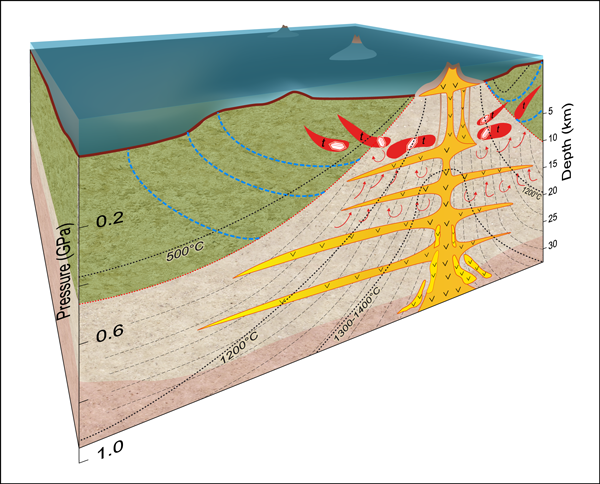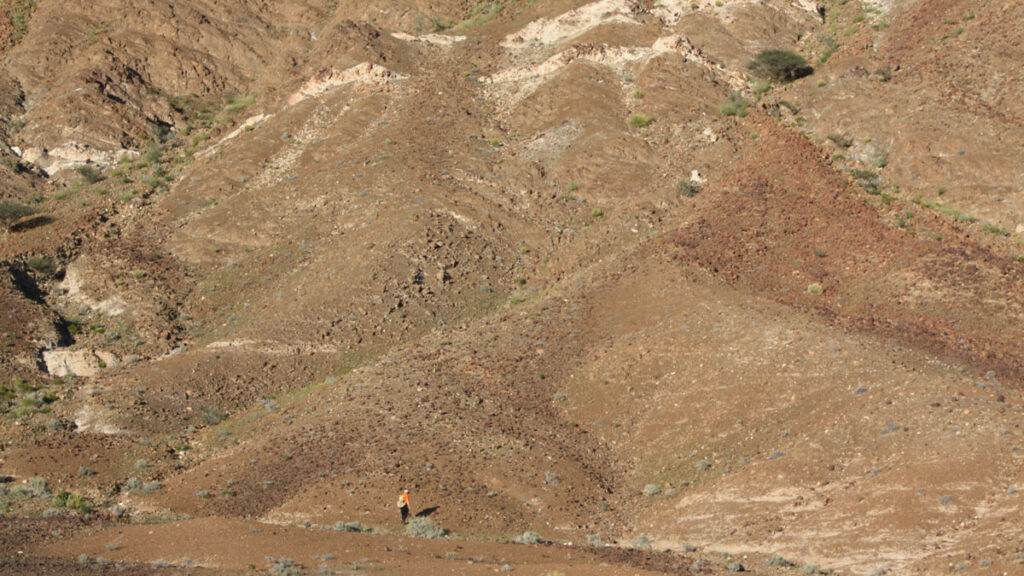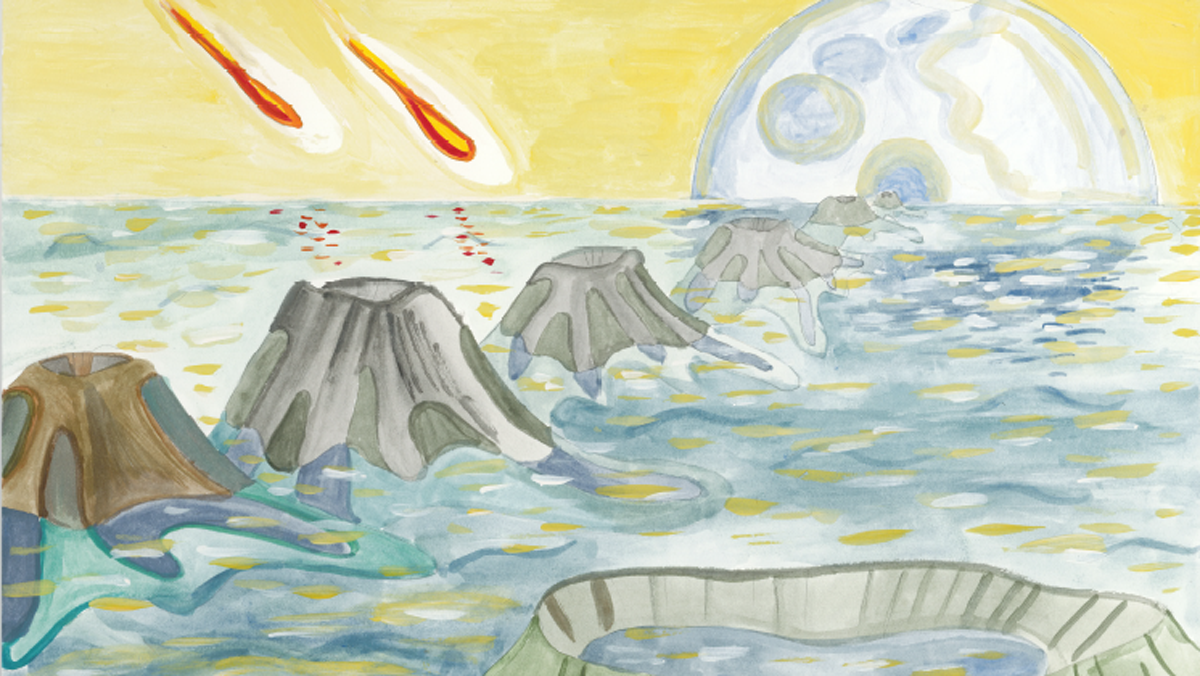Earth’s continental crust, on which billions of people and countless land animals and plants spend their lives, is distinguished by its predominantly felsic composition. That is, this crust contains large proportions of silicon, oxygen, aluminum, and alkali metals like sodium and potassium, and it is largely made up of quartz and feldspar minerals. Felsic continental crust as old as 4 billion years has been recognized on Earth’s surface, and we know it was associated with basaltic oceanic crust made of minerals rich in calcium, magnesium, and iron, such as plagioclase feldspar, olivine, and pyroxenes. But the planet’s earliest rigid outer shell—its primordial crust, which crystallized from the magma ocean covering the nascent Earth about 4.5 billion years ago—probably looked very different.
When and how the first felsic crust formed are questions researchers have pondered for decades. Unfortunately, a handful of microscopic zircons, accessory minerals commonly found in felsic rocks, from a few places around the world are the only remnants from the Hadean eon, the first 500 million years of Earth’s existence. In the almost complete absence of early crustal rocks, scientists have thus had to piece together their hypotheses from indirect evidence.
Recently, our research group completed laboratory experiments and numerical modeling that revealed evidence of a felsic rock-forming reaction that may have occurred on Hadean Earth and may have been responsible for creating the planet’s first continental crust.
Continental Crust Through the Ages
Present-day continental crust is formed by magmatism at volcanic arcs above subduction zones, like the Aleutian Arc off Alaska, the Izu-Bonin-Mariana Arc in the western Pacific, and the Andes in South America. As water in a subducting oceanic slab (crust and mantle) is driven off by the high heat at depth (50–100 kilometers below the surface), it promotes partial melting of overlying mantle rocks (e.g., peridotites). The buoyant melt then rises to the surface, where it interacts with existing crust, cools, and solidifies underground or erupts from volcanoes. The result is new continental crust of dioritic to tonalitic composition. This process has operated efficiently for at least the past 2.5 billion years.
The nature and genesis of continental crust in Earth’s most remote past—during the Hadean, more than 4 billion years ago—are a mystery.
Before that, in the Archean (starting 4 billion years ago), when Earth was hotter, continental crust formed directly from partial melting of hydrated oceanic crust in “vertical drips” of basaltic crust before the beginning of plate tectonics around 3.2 billion years ago or in warm subduction zones afterward [e.g., Shirey and Richardson, 2011; Gerya, 2019]. Archean continental crust is made of tonalites, trondhjemites, and granodiorites (TTG): felsic rocks with a higher sodium content than modern continental crust. However, the nature and genesis of continental crust in Earth’s most remote past—during the Hadean, more than 4 billion years ago—are a mystery.
Many hypotheses have been suggested to explain the formation of felsic, zircon-bearing crust in the Hadean, although so far none have been sufficiently convincing. Some researchers favor a Hadean context in which felsic crust formation was very similar to that on modern Earth [Harrison, 2020], whereas others think that it resembled processes occurring in the Archean. All of these researchers have assumed that the parental magmas of the Hadean zircons formed at depths of 30–50 kilometers from protolith (sediments or a basaltic protocrust) that had previously interacted with liquid water [e.g., Drabon et al., 2021].
Faltys and Wielicki [2020] suggested a crucial role of meteorite impact–induced magmatism in the formation of the first felsic continental crust. However, in most cases, a role for early plate tectonics is assumed, even though evidence from geochemical and geodynamic modeling studies suggests that modern-style plate tectonics did not begin until about 3.2 billion years ago.
An Unintended Discovery
Our research group did not set out to establish how the first continental crust formed. Instead, we were studying interactions among solid rock, magma, and fluids under the ocean to explain the origin of the oceanic mantle-crust transition boundary and adjacent upper mantle rocks (chromitite, dunite, and hydrated peridotites (i.e., serpentinite)). This transition boundary plays a crucial role in controlling the chemical composition and physical properties of oceanic magmatism and crust.
Nail Zagrtdenov, a doctoral student in the Géosciences Environnement Toulouse laboratory at the University of Toulouse III in France, was leading laboratory experiments under the supervision of Anastassia Y. Borisova and Michael J. Toplis. These experiments were designed to replicate the shallow conditions and processes happening at the mantle-crust boundary about 6 kilometers beneath present-day oceanic spreading centers.
In these experiments, we examined interactions between basaltic melts and different proportions of serpentinite rock at temperatures of 1,250°C–1,300°C and pressures of 0.1 to 0.2 gigapascal [Borisova et al., 2021a, 2021b]. Serpentinite, which commonly forms at oceanic ridges, is formed by hydrothermal alteration of peridotite, an ultramafic rock that makes up most of Earth’s upper mantle.
Perhaps we had stumbled onto the explanation for the formation of early felsic crust.
Our experimental results surprised us. As expected, we saw chromitite and dunite form at 0.2 gigapascal. However, we also observed felsic melts—the starting material for continental crust—forming amid the dense, dark, olivine-rich serpentinized peridotite. Production of felsic melts from hydrated peridotites at such shallow conditions was a novel observation, and we began to think that we had unintentionally reproduced conditions that were prevalent more than 4 billion years ago. Perhaps we had stumbled onto the explanation for the formation of early felsic crust.
To investigate further, we followed up our experiments by simulating the same conditions using thermodynamic numerical modeling. This modeling confirmed that felsic melts could be produced from the same starting materials and remain stable at pressures of 0.1 to 0.2 gigapascal (3–6 kilometers depth). With the combined laboratory and modeling results, our multidisciplinary team of French, German, American, and Russian researchers became convinced we had established the ingredients and the physical and chemical conditions necessary to form the very first felsic crust on Earth—and possibly on Mars [Borisova et al., 2021a].
A New Model for Early Crust
Publishing our data and interpretations was rather difficult. Indeed, these results were entirely new, and some researchers were skeptical. Most previous hypotheses had proposed that the first continental crust resembled either present-day continental crust or Archean continental crust in terms of its formation processes and conditions. The conditions and ingredients of our experiments, and the felsic melts they produced, suggest a completely different scenario.
Our model posits that liquid water existed on early Earth’s surface [Valley et al., 2002]. The idea that the protolith of the magmas from which Hadean zircons crystallized had previously interacted with liquid water is accepted on the basis of oxygen isotope data from these zircons [Mojzsis et al., 2001]. However, considering hydrated peridotite as a possible protolith is a novel suggestion (Figure 1).

The young planet’s magma ocean would have had the same peridotitic composition as the mantle. As the magma ocean cooled and crystallized, a thin peridotite crust could have quenched atop the ocean while gases, including water vapor, were expelled from the magma. These gases would have built a primitive atmosphere, from which liquid water would have condensed to the hydrosphere. The primitive peridotitic crust would have rapidly interacted with the liquid water, yielding serpentinites [Albarède and Blichert-Toft, 2007]. This possibility has not received much consideration from researchers, who typically assume the Hadean protocrust was basaltic, comparable to the present-day surfaces of asteroids and protoplanets.
In our model, basaltic magmas would have formed as the last differentiate liquids remaining at the very end of the crystallization of the magma ocean, and then they would have locally intruded and mixed into the uppermost serpentinized crust. Interaction between magma and protocrust material would have caused dehydration of the serpentinized peridotite. Afterward, the peridotite would have partially melted to produce felsic melts at shallow depth—as we observed in our experiments. These melts would have then cooled to form the first felsic crust (Figure 1). Frequent meteorite impacts in the Hadean could have aided in this mixing and interaction by fracturing, heating, and promoting water convection through and partial melting of the protocrust.

We see evidence of such felsic rock formation in the field. For example, felsic (plagiogranitic) rocks are exposed now amid hydrated peridotitic mantle rocks in the Semail ophiolite in Oman, which formed at a depth of less than 10 kilometers below the surface.
Further Explorations
The scenario offers a simple and efficient recipe that we believe explains the origin of Hadean felsic crust well.
The scenario of interacting serpentinized rocks and basaltic magmas offers a simple and efficient recipe that we believe explains the origin of Hadean felsic crust well for several reasons. First, it requires the existence of shallow liquid water on the early terrestrial surface (Figure 1). Second, it involves plausible shallow interactions between hydrated peridotite and basaltic melts resulting from shallow magmatism or impact-induced melting. Third, in agreement with existing geodynamic models for the Hadean, it does not require plate tectonics. Furthermore, our experimental felsic melts can crystallize low-temperature zircons very similar to observed detrital Hadean zircons [Borisova et al., 2021b].
To further develop this model and understand the origins of the first planetary continental crust, we plan to conduct further experiments involving pressure gradients and shock process modeling. This work is necessary to explore mineral dehydration and melt channelization happening during shock processes, melt percolation, and reequilibration of the percolating melt with the hydrated peridotite. Such work should increase the applicability of our experimental results to phenomena occurring throughout the Hadean eon and will help develop our new model of primordial processes happening on early Earth and Mars.
We are also planning new experiments to reproduce conditions on Mars and study whether our new results could relate to processes that happened on the neighboring planet. Like Earth, early Mars had water on its surface sometime after the crystallization of a primordial crust from a magma ocean. Importantly, the composition of our experimental felsic melts is similar to that of felsic rocks that Curiosity discovered on Mars [Sautter et al., 2015]. Thus, it seems worthwhile to compare conditions on the two planets.
Current explorations of Mars may help validate and complement our hypothesis regarding the early evolution of water-bearing rocky planets. New seismic data from the InSight (Interior Exploration using Seismic Investigations, Geodesy and Heat Transport) lander, coupled with crustal and thermal modeling based on InSight data, have provided new information on the depth and structure of the Martian crust [e.g., Knapmeyer-Endrun et al., 2021]. Analysis so far indicates that Mars’s relatively weak gravitational field, which is only about 40% as strong as Earth’s, suggests early felsic crust on the planet could have been located deeper than it was on Earth—at depths of 25–30 kilometers compared with the corresponding Hadean felsic crust generated less than 10 kilometers deep on Earth.
There is much more to learn about early crust-forming processes and conditions on Earth—and Mars. But the mechanism described here may represent the most plausible idea yet of how large volumes of the first felsic crust were made, answering a decades-old question in Earth science.
Acknowledgments
Investigations of the mantle section of the Oman ophiolite are supported by Institut National des Sciences de l’Univers of the Centre National de la Recherche Scientifique (INSU-CNRS) under grant PLAGIOGRAN 2021-2023.
References
Albarède, F., and J. Blichert-Toft (2007), The split fate of the early Earth, Mars, Venus and Moon, C. R. Geosci., 339, 917–927, https://doi.org/10.1016/j.crte.2007.09.006.
Borisova, A. Y., et al. (2021a), Hydrated peridotite – basaltic melt interaction. Part I: Planetary felsic crust formation at shallow depth, Front. Earth Sci., 9, 640464, https://doi.org/10.3389/feart.2021.640464.
Borisova, A. Y., et al. (2021b), Hadean zircon formed due to hydrated ultramafic protocrust melting, Geology, doi:10.1130/G49354.1, in press.
Drabon, N., et al. (2021), Heterogeneous Hadean crust with ambient mantle affinity recorded in detrital zircons of the Green Sandstone Bed, South Africa, Proc. Natl. Acad. Sci. U. S. A., 118, e2004370118, https://doi.org/10.1073/pnas.2004370118.
Faltys, J. P., and M. M. Wielicki (2020), Inclusions in impact-formed zircon as a tracer of target rock lithology: Implications for Hadean continental crust composition and abundance, Lithos, 376–377, 105761, https://doi.org/10.1016/j.lithos.2020.105761.
Gerya, T. (2019), Geodynamics of the early Earth: Quest for the missing paradigm, Geology, 47, 1,006–1,007, https://doi.org/10.1130/focus102019.1.
Harrison T. M. (2020), Hadean Earth, Springer, Cham, Switzerland, https://doi.org/10.1007/978-3-030-46687-9.
Knapmeyer-Endrun, B., et al. (2021), Thickness and structure of the Martian crust from InSight seismic data, Science, 373, 438–443, https://doi.org/10.1126/science.abf8966.
Mojzsis, S. J., T. M. Harrison, and R. T. Pidgeon (2001), Oxygen-isotope evidence from ancient zircons for liquid water at the Earth’s surface 4,300 Myr ago, Nature, 409, 178–181, https://doi.org/10.1038/35051557.
Sautter, V., et al. (2015), In situ evidence for continental crust on early Mars, Nat. Geosci., 3, 605–609, https://doi.org/10.1038/ngeo2474.
Shirey, S. B., and S. H. Richardson (2011), Start of the Wilson cycle at 3 Ga shown by diamonds from subcontinental mantle, Science, 333, 434–436, https://doi.org/10.1126/science.1206275.
Valley, J. W., et al. (2002), A cool early Earth, Geology, 30, 351–354, https://doi.org/10.1130/0091-7613(2002)030<0351:ACEE>2.0.CO;2.
Author Information
Anastassia Y. Borisova ([email protected]) and Anne Nédélec, Géosciences Environnement Toulouse, France


